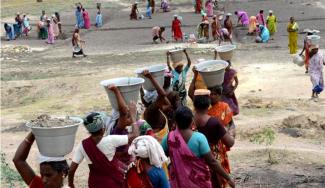Prime Minister Narendra Modi (in)famously said that MNREGA is the epitome of failure of the previous governments, as even after 60 years of independence, people were being sent to dig pits as a means to provide employment. In a satirical tone, Modi added that he will not discontinue the program, but would keep it going to highlight the failure of previous governments. He had to retract his words when he had to rely on MNREGA during covid pandemic, when forced migration due to unplanned lockdown ensured that the only means of providing sustenance to the people was this rural employment guarantee scheme. In reality, despite continuing the scheme, the BJP government did not give due attention to MNREGA. After ten years of being in power, along with tall talks being laid bare, lackluster economic performance and record breaking unemployment rates, the Modi government’s buzzing confidence to denounce MNREGA may have reduced. But through systematic budget cuts, an attempt to bury the scheme is being made.
In last years budget, i.e., 2023-24, the fund allocation to MNREGA was slashed to Rs. 60,000 crore from Rs. 73,000 crore in 2022-23, while the revised estimate for 2022-23 stood at Rs. 89,000 crore. The average rural employment provided under MNREGA is also dwindling in the past few years, with 2023-24 data showing 46 days of employment (as per latest data available till January 2024). The average wage in 2023-24 stands at Rs. 237 per day, as compared to Rs. 132.70 per day in 2013-14, i.e., in the past 10 years, wages have increased only by a mere Rs. 115! Adjusted against the Consumer Price Index (CPI) of rural areas, the percentage annual increase in real wages paid under MNREGA during the BJP regime stands at a meagre 1.15%, whereas the national average wage rate paid under MNREGA is much lower than the prevailing market rates in most states, thus ensuring the decline in demand for MNREGA. The Minimum Wages Act was made inapplicable to MNREGA beneficiaries, and several social activists deemed this to be unconstitutional. The same came to be challenged and the matter is pending before the Supreme Court, even as MNREGA workers struggle to meet ends with their paltry wages. Apart from low wages, informal administrative ways and artificial ways are used to suppress demand. For example, when workers approach the Panchayat demanding MNREGA work, they are turned away for reasons that there is no work available due to shortage of funds. When workers are turned away, their application forms are not received, which means that the demand for such work does not enter the system, which is shown as the reason for budget cuts.
It is in this context that one must analyze the statement of Minister of Development Giriraj Singh, who said in Lok Sabha, that around five crore jobs have been removed in 2022-23, as opposed to the data which stood at 1.5 crore in 2021-22. Reasons cited for such a drastic increase in job removals was due to “fake” job cards, duplicity of job cards, no demand for work, shifting of residences of workers, or workers’ death, etc. However, the scale of job removals raise suspicions on external interferences which holds the motive to flush out the scheme. The current data shows that in 2023-24 (until January 22, 2024), 7.66 crore individuals worked under MNREGA, and for the completed year of 2022-23, it stood at 8.75 crore. In 2013-14, the number of individuals working under MNREGA stood at 7.38 crore. Even by taking into account the absolute increase in casual and manual workers in rural area, who form the base for MNREGA, and the period of ten years, it is not difficult to come to the conclusion that MNREGA has been forced to not keep pace with the actual requirements. It must also be highlighted here that when only less than 3% of households engage in MNREGA, and complete 100 days of work, will they be entitled to the present scale of allocation.
The social activists who engage with MNREGA state that the level of allocation in the last programme is “killing the law”. As per their estimates, an allocation of Rs. 2.72 lakh crore is required to ensure that legally entitled quota of 100 days of work for all households in the current year are met. The budget allocation has come down from 2.4% in 2016-17 to 1.3% in 2023-24.
It is in this context that we have to factor the 5 crore job cards being cut in a single year under MNREGA! The numbers analyzed clearly indicate that the present ruling dispensation is hell bent on damaging and destroying the largest programme of demand-driven rural public employment of the country. It is for the progressive and democratic forces, fighting for people’s rights to organize workers and safeguard MNREGA.











